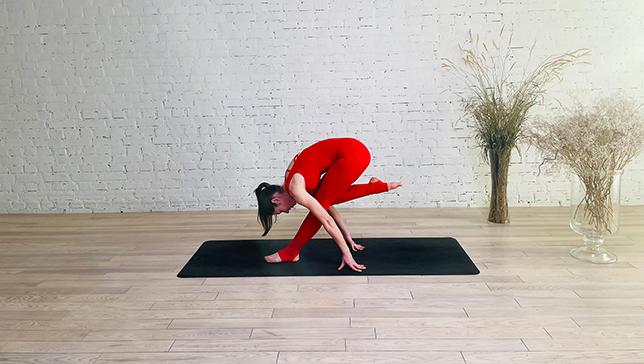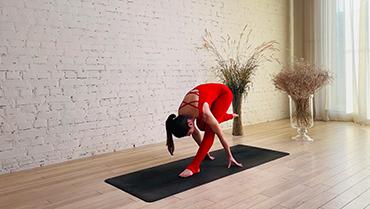Flamingo Pose - Parsvottanasana Variation

Contents
Flamingo Pose, also known as Parsvottanasana Variations, is a standing forward bend pose that is commonly practiced in yoga.
Flamingo Pose is great for stretching the hamstrings, hips, and spine. It can also help to improve balance and stability, and can be a good preparatory pose for more advanced forward bends. As with any yoga pose, it’s important to listen to your body and work within your own range of motion, avoiding any pain or discomfort.
Pose Detail
- Difficulty: Advanced
- Body Position: Arm & Leg Support, Forward Bend Yoga Poses, Standing Yoga Poses
- By Type: Arm Balance Yoga Poses, Balancing Yoga Poses, Flexibility Yoga Poses, Strengthening Yoga Poses
- By Benefit: Yoga Poses For Digestion, Yoga Poses For Stress Relief
Step-by-Step Instructions
Benefits and Contraindications
Improves posture. .
Calms the brain
Strengthens the legs and spine
Aids digestion
Stretches the spine, hip muscles and hamstrings
Low back pathologies. Ankle, knee, or hip injury.
Shoulder injury
Migraine
High or low blood pressure
Ankle, knee, or hip injury
Photo poses in different angles

Modifications and Props for Beginners
- If reaching the ground with your hands is difficult, you can use yoga blocks or a chair to support your hands.
- Place the blocks or chair at a height that allows you to maintain a straight spine.
Useful Tips
- Keep your spine straight as you fold forward. Avoid rounding the back.
- Keep the hips squared towards the front of the mat.
- Engage your core muscles to help support your spine and maintain balance.
- Focus on your breath and try to deepen the stretch with each exhale.
- If you feel any pain or discomfort, ease out of the pose or modify it as needed.
Frequently Asked Questions
Be careful not to overstrain your knee or ankle joints, and avoid this pose if you have any injuries or pain in these areas. Also, be sure to engage your core muscles to protect your lower back.
It’s always best to consult with your doctor or a qualified prenatal yoga instructor before practicing any yoga poses during pregnancy. In general, balancing poses like flamingo pose may become more difficult during pregnancy due to changes in weight distribution and center of gravity.
If you have a regular yoga practice and feel comfortable with the pose, you may be able to continue practicing flamingo pose during the early stages of pregnancy with modifications and proper support. However, as your pregnancy progresses, it may be best to avoid balancing poses altogether or only practice them with the support of a wall or chair.
It’s important to listen to your body and not push yourself beyond your limits during pregnancy. Always consult with your healthcare provider before starting or continuing any exercise program during pregnancy.
The length of time you hold Flamingo Pose can vary depending on your experience and comfort level with the pose. Generally, you can hold the pose for 30 seconds to one minute on each leg.
If you are a beginner, you may find it helpful to start with shorter holds and gradually work your way up to longer holds as your balance and strength improve. Remember to breathe deeply and maintain a steady gaze to help you maintain your balance and focus during the pose.
It’s important to listen to your body and not push yourself beyond your limits. If you feel any discomfort or strain, come out of the pose and take a break.
While practicing Flamingo Pose (also known as Tree Pose), there are a few key things to focus on:
- Balance: Focus on grounding down through your standing foot and lifting up through your lifted foot. Engage your core muscles to help maintain your balance.
- Alignment: Make sure your standing foot is rooted firmly on the ground, and that your lifted foot is pressing into your inner thigh or calf. Keep your hips level and facing forward, and avoid leaning to one side.
- Breath: Take slow, deep breaths in and out through your nose. This will help you maintain your focus and calm your mind.
- Gaze: Fix your gaze on a steady point in front of you to help maintain your balance and focus.
- Relaxation: Try to relax your shoulders and facial muscles. Avoid holding tension in your body, which can make it more difficult to balance.
Remember to practice Flamingo Pose mindfully, with awareness and focus on the present moment. It’s normal to wobble and lose your balance at first, so be patient and persistent in your practice.